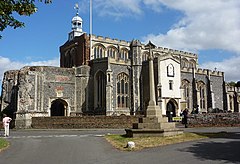East Bergholt
| East Bergholt | |
|---|---|
 Church of St Mary the Virgin |
|
| East Bergholt shown within Suffolk | |
| Population | 2,765 (Including Flatford 2011 Census) |
| OS grid reference | TM072351 |
| District | |
| Shire county | |
| Region | |
| Country | England |
| Sovereign state | United Kingdom |
| Post town | COLCHESTER |
| Postcode district | CO7 |
| Dialling code | 01206 |
| Police | Suffolk |
| Fire | Suffolk |
| Ambulance | East of England |
| EU Parliament | East of England |
| UK Parliament | |
East Bergholt is a village in the Babergh District of Suffolk, England, just north of the Essex border.
East Bergholt and Hadleigh are the largest villages in the Stour Valley, a region historically known for its manufacture of linens The nearest town and railway station is Manningtree, Essex. East Bergholt is ten miles north of Colchester and 8 miles south of Ipswich. Schools include East Bergholt High School, a comprehensive for children aged 11-16, and a primary school.
During the 16th century, its inhabitants became well known for Protestant radicalism A few of its citizens were martyred during the reign of Queen Mary I, and the Protestant martyrologist John Foxe recorded their stories in his famous work Acts and Monuments (also known as Foxe's Book of Martyrs).
East Bergholt is the birthplace of painter John Constable whose father owned Flatford Mill. Flatford and Dedham, Essex, both made famous by John Constable, are within walking distance of East Bergholt.
The central area of the village includes a variety of businesses:
The Church of St Mary the Virgin was built in the 15th and 16th centuries, but is well known for the absence of a tower or spire to house the bells. Work began on a tower in 1525, but Cardinal Wolsey's fall from grace in 1530 brought construction to a halt and the following year a wooden bell cage was erected in the churchyard. This temporary structure still exists although not in its original position. It was moved from the south to the north side of the church in the 17th century because the occupant of Old Hall objected to the noise of the bells.
...
Wikipedia

